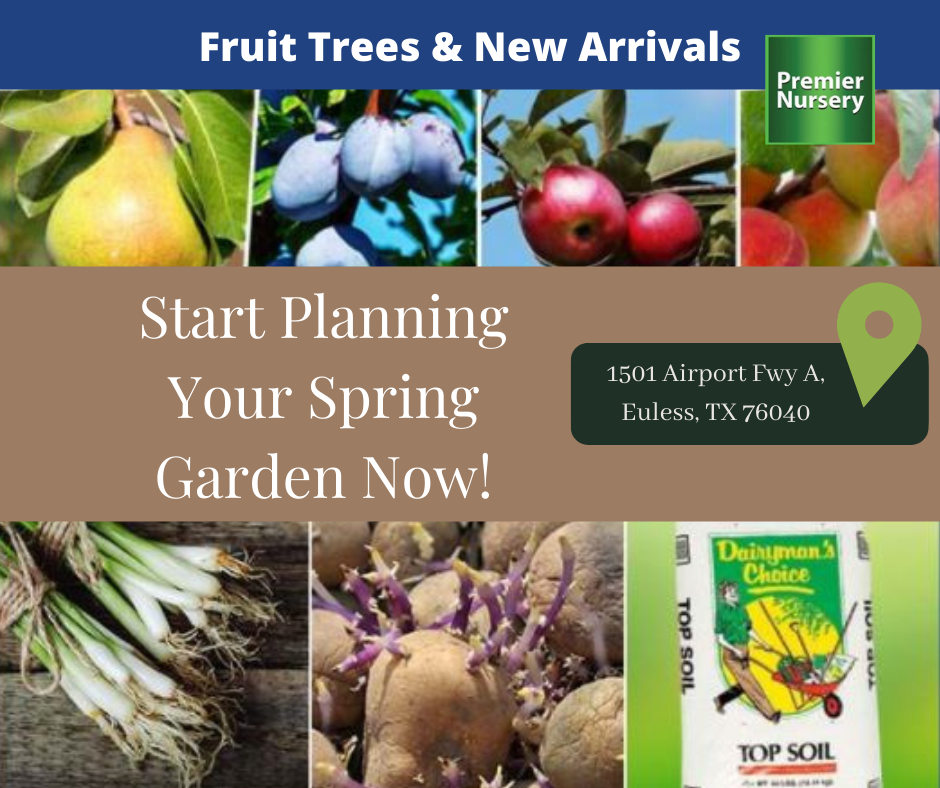A gardener’s work is never really done. Even though winter is in full swing, spring is right around the corner, and now is the time to begin preparing your spring vegetable garden. According to the Farmer’s Almanac, the last spring frost for the Dallas/Fort Worth Area is March 27, 2022, and there are several things you must do before the temperatures warm up. Consider taking the following steps to help you get ready for your spring 2022 garden!
Lay Down Mulch

Mulch should be laid down as early as possible because the benefits don’t show up immediately – rather, they show up over time. Laying mulch down early allows the organic matter to break down and feed the soil.
- Mulch prevents the gardener from having to dig or till the soil. This is seen predominantly in permaculture, where a thick layer of mulch is laid down and, over time, the organic matter in the mulch decomposes, leaving perfectly nutritious compost behind. This is often referred to as “gardener’s gold.”
- Mulch prevents erosion. This is because the wood chips create a complex web of interlocked matter that doesn’t wash away easily, even in heavy downpours responsible for erosion.
- Mulch absorbs water and maintains proper hydration levels.
- Although mulch isn’t a fail-proof method for keeping weeds out, it does successfully smother the majority of weeds that easily grow in your garden.
- Because mulch is made of organic matter, it also attracts an abundance of earthworms. Earthworms are not only vital to the nutritional success of your garden, but they’re a great sign that your garden is already in nutritional good standing!
Once you’re ready to put crops into the ground, simply push the mulch aside, place your crops or seeds directly into your soil.
Test and Amend Your Soil

Different plants require different pH levels. After you’ve added soil to your garden, it’s important to test your soil’s pH so that you have enough time to amend it before crops go into the ground.
For an easy guide on how to test your soil, check out our other article here!
Design Your Garden

While gardening is trial and error, no matter how many years you’ve been doing it, it’s incredibly important to spend time considering where in your garden your crops will grow rather than placing them randomly. That’s because some crops actually suffer when placed with the wrong garden companion. For example, pepper and onions don’t like beans, and cabbage doesn’t like cauliflower. Understanding what plants should be companions to other plants is one of the biggest reasons you should spend time designing your garden.
Another reason you should spend time designing your garden is that you can save a ton of space with the right designs! If your desire is to grow abundant harvests, you’ll want all the space you can get. Whether you prefer the square-foot gardening method or the traditional growing in rows, placing thought and purpose behind the crops’ placements is the best step you can take now for a successful spring garden.
Premier Nursery also specializes in landscaping services that include installation of sod, grading, courtyard entryways, drain and irrigation repair, and more! If you have any questions about our landscaping services, don’t hesitate to contact us!
Get a jump start on buying your crops now!

It’s a good idea to go ahead and purchase your cold-hardy crops now. Of course, you don’t have to put them in the ground right away. Buying them now ensures that you can begin hardening them off and preparing them for going in the garden when the time is right.
A few crops you can purchase already from Premier Nursery are:
- Onion Slips. Onions are cold-season crops, meaning they should go into the ground very soon. Onions are planted in the spring and harvested in the fall when the green tops begin to die off. Onion slips, or sets, are not the same things as the kind you get from the store. These are ground-ready and mature in roughly three to four months.
- Seed Potatoes. Like onions, seed potatoes aren’t the same thing as grocery store-bought potatoes. These are grown specifically for reproduction and are ready to go in the ground. You should plant your seed potatoes two weeks after the last frost, or once the soil can be worked. In preparation for planting your seed potatoes, cut your potatoes into golf ball-sized chunks, ensuring that there are one to two eyes per chunk. If the potato is small, don’t cut it. This should be done at least two days before planting so that the open “wounds” have time to heal and harden over.
Ask us about how to get a jump start on your fruit trees for your spring garden!
- Peaches
- Plums
- Apples
- Pears
- Grape Vine
- Blackberries



